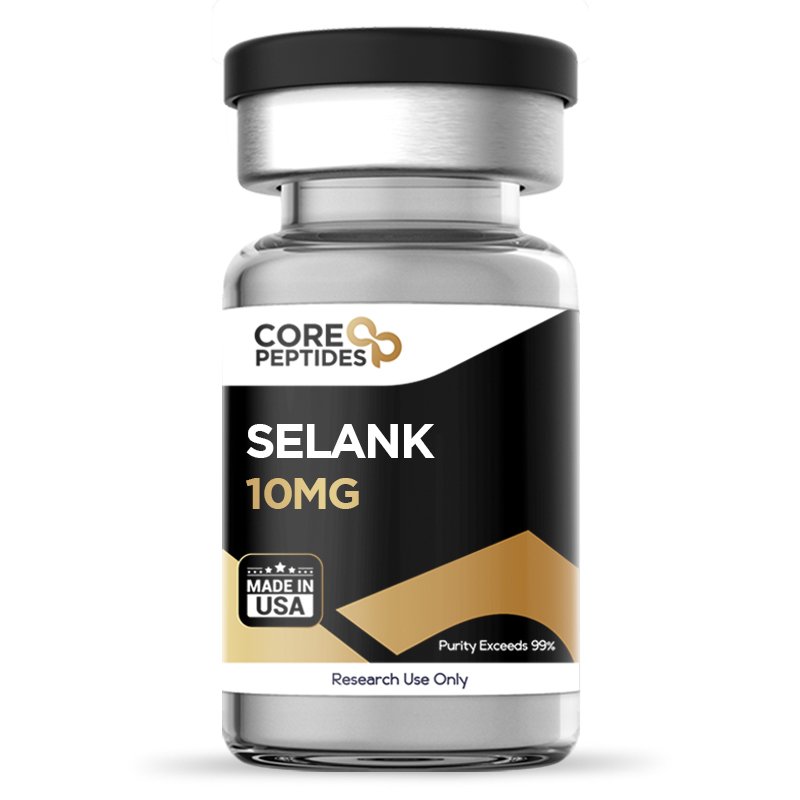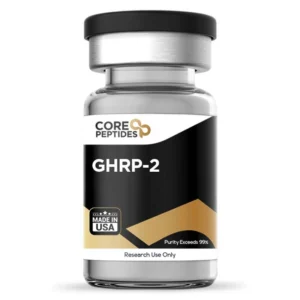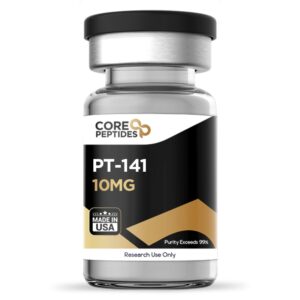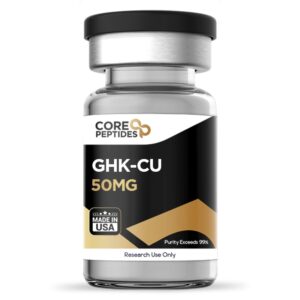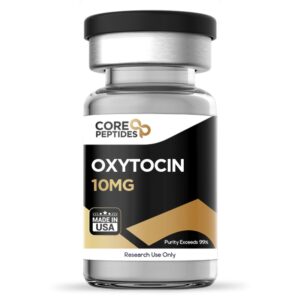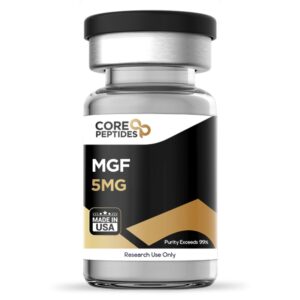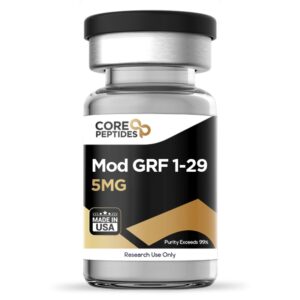Selank (10mg)
$52.00
Size: 10mg
Contents: Selank (10mg)
Form: Lyophilized powder
Purity: >99%
SKU: P-SELANK-10
FREE Shipping on $200+ orders
Discount per Quantity
| Quantity | Discount | Price |
|---|---|---|
| 5 - 8 | 5% | $49.40 |
| 9 + | 10% | $46.80 |
Selank Peptide
Selank is a short, synthetic heptapeptide composed of seven amino acids. Selank was developed to mimic the naturally occurring peptide Tuftsin,(5) a short fragment from the immunoglobulin G (IgG), a natural tetrapeptide involved in certain biological functions that regulate the immune system. After the discovery and initial isolation of Tuftsin, researchers suggested that the peptide might be involved in the functions of phagocytic cells, including phagocytosis, motility, and immunological cell functions.(2) Since then, various synthetic analogs of Tuftsin have been synthesized in laboratories by conventional and polymeric reagent methods.(4)
Overview
Selank is a peptide chain composed of two fragments – one is Tuftsin at the N-terminus, and the other is a tripeptide Pro-Gly-Pro (PGP) at the C-terminal end of the molecule. The inclusion of a Pro-Gly-Pro (PGP) sequence in the peptide Selank might enhance its potential to penetrate various biological barriers, including the blood-brain barrier (BBB). The BBB is a highly selective and semi-permeable membrane that delineates the circulating blood from brain tissues and extracellular fluid within the central nervous system. It is deemed to play a pivotal role in controlling the entry of molecules. Integrating the PGP sequence might modify the peptide's hydrophilicity or lipophilicity, which might increase its compatibility with the lipid-rich milieu of the BBB. Moreover, the PGP motif might interact with certain transport systems or receptors on the BBB membrane, potentially facilitating receptor-mediated endocytosis or active transport. These mechanisms may permit Selank to circumvent the tight junctions that typically impede the transit of larger molecules through the BBB. Additionally, the presence of the PGP sequence might alter the tertiary structure of Selank, potentially rendering it more amenable to traversing the BBB. This alteration might arise from changes in the peptide's spatial configuration, which may influence its interaction with the cellular components of the BBB.(6)
Chemical Makeup
Molecular Formula: C33H57N11O9
Molecular Weight: 751.88 g/mol
Other Known Titles: TP-7, Selanc
Research and Clinical Studies
Selank Peptide and BDNF Levels
There is a possibility that Selank may influence the expression of brain-derived neurotrophic factor (BDNF), deemed a crucial protein in the brain that supports neuronal survival and growth.(1) Research indicates that Selank may markedly increase the levels of BDNF mRNA in the hippocampus, an integral region of the brain involved in memory and emotional responses. The potential of Selank to boost BDNF expression, particularly under conditions where stress and glucocorticoids suppress BDNF levels, suggests its relevance in research studies within the context of neuroplasticity decline. This protein's perceived role in synaptic function and neuronal adaptation underscores the significance of such investigations.
Selank Peptide and Serotonin Signaling
Selank may potentially influence serotonin signaling mechanisms. Serotonin signaling is theorized to play a crucial role in the management of mood and anxiety within the brain. Research utilizing murine models where serotonin synthesis was inhibited has indicated that Selank might be able to alter serotonin levels in cases where the serotonergic system is impaired. It has been proposed by researchers that Selank may potentially boost serotonin metabolism in the brainstem, indicating its potential action on the serotonin system. More specifically, the peptide is thought to facilitate an increase in the metabolic processing of serotonin in brain regions considered essential for mood and anxiety regulation. Additionally, the hypothesis that Selank may enhance serotonin metabolism suggests a potential pathway by which Selank might ameliorate issues stemming from diminished serotonin activity.
Selank Peptide and GABA Signaling
Studies have suggested that Selank may act on the gamma aminobutyric acid (GABA) receptors. GABA is considered an inhibitory neurotransmitter within this context, playing a role in diminishing neuronal excitability, fostering relaxation, and mitigating anxiety observations, as observed in animal research models. In one study,(7) the expression of 84 genes involved in neurotransmission was studied in murine models. The experimental murine models were exposed to either Selank or GABA, and gene expression was studied after one and three hours via a PCR method. All the gene expressions studied for Selank and GABA appeared positively correlated. The results suggested that Selank had the potential to induce several alterations in the neurotransmission process, suggesting by proxy that Selank may exert possible action via modulating the GABAergic system. Moreover, the literature indicates that the influence of Selank might not be confined to mere direct actions on the transcriptional activity of genes associated with GABA receptors. It might also involve allosteric modulation of the GABAergic system. This is inferred from observed variations in gene expression following exposure to Selank compared to GABA, where Selank has been speculated to distinctly affect the expression of specific genes. Such differential gene expression alludes to a more complex interaction of Selank with the GABAergic system, possibly diverging from the direct receptor activation typically seen with GABA. Selank has also been proposed to instigate enduring modifications within neurotransmitter systems, a characteristic that might account for its extended anxiolytic actions observed in experimental frameworks. These alterations suggest a broader and potentially long-term impact on neurotransmitter dynamics beyond potential receptor interaction, emphasizing the complex potential of Selank on neural regulation.
Selank Peptide and Genome Expression
Studies have been conducted to understand the potential of Selank peptide on genome expression and its involvement in the inflammatory process. These studies(8) were conducted on male murine models weighing 250 grams. These murine models were separated into three groups – a control group, an experimental group with a single exposure to Selank, and an experimental group under routine exposure to Selank. After the study, the RNA was isolated from the rat spleen and hippocampus and studied via PCR method. Based on the results, it was suggested by the researchers that Selank might have the potential to impact gene expression, exhibited more definitively in the spleen and the hippocampus. One of the gene expressions reported during the study was the change in CX3CR1, which was involved in the inflammatory process. This suggested that Selank might regulate the inflammatory process through the mechanism of gene expression, mainly the CX3CR1 alteration.
Selank Peptide and Enkephalin Signaling
In a clinical study,(9) 62 research models of Generalized Anxiety Disorder (GAD) were examined. These models were divided into two groups – 48% were exposed to Selank, whereas 52% were exposed to a generic benzodiazepine compound. Following the study, the psychometric levels of all models were analyzed. Results suggested that the impact of Selank appeared to be similar to those of the generic compound. Researchers also reported that enkephalin levels of tau leu-enkephalin were apparently reduced in the Selank-exposed group before the experiment, and the addition of Selank may have reversed this observation. Selank is hypothesized to exert suppressive actions on enzymes that break down enkephalins. Enkephalins, which are endogenous ligands for opioid receptors, have been implicated in the regulation of pain, mood, and stress responses. Therefore, the potential inhibition of these degrading enzymes by Selank might result in increased levels of enkephalins, potentially augmenting their physiological actions. This could lead to a noticeable elevation in tau(1/2) leu-enkephalin concentrations during experiments involving anxiety models where Selank is evaluated.
Selank Peptide and Memory
This study(11) was conducted on murine models that were enrolled in a "training" session of four days for learning conditioned avoidance response (CAR). CAR is a learned response in delaying or preventing avoidance behavior. Selank exposure was begun 15 minutes before the training session on all four days. Upon monitoring the behavior of the murine models, researchers suggested that the learning abilities of the murine models appeared to improve with each exposure of the peptide, as the number of errors reduced and the number of correct solutions increased. This potential impact might be mediated through multiple interconnected pathways, including the modulation of neuropeptide systems within the brain. These neuropeptides are deemed critical as they are believed to play significant roles in various cognitive functions, potentially boosting processes related to learning and memory. Additionally, the peptide Selank might alter neural circuits involved in memory consolidation. This alteration may enhance synaptic stability and efficiency in learning processes. Moreover, Selank might indirectly boost cognitive performance by mitigating anxiety-related factors that frequently impede learning efficiency. This suggests that Selank may influence the emotional aspects of cognition, enhancing the overall cognitive process. Furthermore, Selank may promote neural plasticity or the capacity of neurons to adapt, particularly in cognitive circuits that are not performing optimally, thus potentially elevating their function. This enhancement of neural adaptability may be vital for the maintenance and improvement of cognitive abilities, suggesting that Selank might be a valuable compound for further research in neurocognitive fields.
Selank Peptide and Immunomodulation
This clinical study(12) was conducted on research models of GAD with neurasthenia, with a control group and experimental group exposed Selank peptide for 14 days. After the study, the peripheral blood samples were collected and analyzed. The analytical results suggested peak elevation in the levels of IL-6 cytokine and changes in the Th1 and Th2 cytokine ratio, all of which are believed to regulate the immune system.
Selank Peptide and Withdrawal
In this study,(13) murine models were infused with 10% ethanol as their sole fluid source for 24 weeks. Consequently, these murine models were experimentally induced with alcohol withdrawal symptoms once the ethanol drip was removed. The murine models were then exposed to Selank, to study its potential impact on the withdrawal symptoms. After 48 hours, researchers reported that the alcohol withdrawal symptoms appeared to have reduced, based on the results of their social interaction and maze tests.
Selank Peptide and Cardiovascular Activity
In this study,(14) Selank was presented to feline models. The main goal of this study was to examine the cardiovascular and respiratory potential of the peptide in this specific model. Upon exposure to the peptide, it was reported by the researchers that there appeared to be a 32% decrease in arterial blood pressure within 3 minutes of peptide presence. Moreover, the peptide possibly induced a 24% increase in cerebral blood flow within the first 10 minutes, slowly decreasing to optimal levels. Selank was not reported to have induced any action on the respiratory system or the heart rate.
Selank Peptide and Weight, Cholesterol
In this study,(15) murine models were first exposed to a high-fat diet for 6 consecutive weeks until the weights of murine models were measured between 280g to 300g. Later, these murine models were divided into two groups, a control group given sodium chloride, and an experimental group exposed to Selank peptide. Additionally, a group of control murine models were used for this study, which were not presented with either of the agents but were simply monitored for the purpose of the study. Upon analysis, it was suggested by the researchers that the Selank group exhibited apparently decreased levels of cholesterol and fat anywhere between 25% and 58%. Based on the findings, Selank may also reduce specific forms such as low-density lipoprotein (LDL), very-low-density lipoprotein (VLDL) cholesterol, and triglycerides. This indicates that Selank might play either a direct or an indirect role in influencing the mechanisms of lipid metabolism and could potentially display actions that lower cholesterol (hypocholesterolemic) and lipid levels (hypolipidemic). Moreover, the investigation noted discernible enhancements in parameters related to hemostasis, including elevated total fibrinolytic activity and decreased platelet aggregation, which may suggest improvements in conditions that favor clot formation. Additionally, the study points to a possible modulatory action of Selank on glucose homeostasis, which involves maintaining stable blood glucose levels. The fat metabolism rate of the Selank group also was reportedly improved and was eventually measured at the same rate as those in control models. Upon weight determination of the murine models, it was noted that the control group exhibited an average weight gain of 40g throughout the study, whereas the experiment group maintained the same weight throughout the study, with gradual weight reduction upon peptide presentation.
Selank peptide is available for research and laboratory purposes only. Please review and adhere to our Terms and Conditions before ordering.
References:
- Inozemtseva, L. S., Karpenko, E. A., Dolotov, O. V., Levitskaya, N. G., Kamensky, A. A., Andreeva, L. A., & Grivennikov, I. A. (2008). Intranasal administration of the peptide Selank regulates BDNF expression in the rat hippocampus in vivo. Doklady biological sciences : proceedings of the Academy of Sciences of the USSR, Biological sciences sections, 421, 241–243. https://doi.org/10.1134/s0012496608040066
- Najjar VA. Tuftsin, a natural activator of phagocyte cells: an overview. Ann N Y Acad Sci. 1983;419:1-11. doi: 10.1111/j.1749-6632.1983.tb37086.x. https://pubmed.ncbi.nlm.nih.gov/6370072/
- Semenova, T. P., kozlovskiĭ, I. I., Zakharova, N. M., & Kozlovskaia, M. M. (2009). Eksperimental'naia i klinicheskaia farmakologiia, 72(4), 6–8.
- Fridkin M, Stabinsky Y, Zakuth V, Spirer Z. Tuftsin and some analogs: synthesis and interaction with human polymorphonuclear leukocytes. Biochim Biophys Acta. 1977 Jan 24;496(1):203-11. https://pubmed.ncbi.nlm.nih.gov/576412/
- Kozlovskaya MM, Kozlovskii II, Val'dman EA, Seredenin SB. Selank and short peptides of the tuftsin family in the regulation of adaptive behavior in stress. Neurosci Behav Physiol. 2003 Nov;33(9):853-60. https://pubmed.ncbi.nlm.nih.gov/14969422/
- Elena Filatova et al., GABA, Selank, and Olanzapine Affect the Expression of Genes Involved in GABAergic Neurotransmission in IMR-32 Cells. https://doi.org/10.3389/fphar.2017.00089
- Volkova, A., Shadrina, M., Kolomin, T., Andreeva, L., Limborska, S., Myasoedov, N., & Slominsky, P. (2016). Selank Administration Affects the Expression of Some Genes Involved in GABAergic Neurotransmission. Frontiers in pharmacology, 7, 31. https://www.ncbi.nlm.nih.gov/pmc/articles/PMC4757669/
- T.A Kolomin et al., Transcriptomic Response of Rat Hippocampus and Spleen Cells to Single and Chronic Administration of the Peptide Selank. June 2, 2009. DOI: 10.1134/S1607672910010023
- Zozulia AA, Neznamov GG, Siuniakov TS, Kost NV, Gabaeva MV, Sokolov OIu, Serebriakova EV, Siranchieva OA, Andriushenko AV, Telesheva ES, Siuniakov SA, Smulevich AB, Miasoedov NF, Seredenin SB. Efficacy and possible mechanisms of action of a new peptide anxiolytic selank in the therapy of generalized anxiety disorders and neurasthenia. Zh Nevrol Psikhiatr Im S S Korsakova. 2008;108(4):38-48. Russian. https://pubmed.ncbi.nlm.nih.gov/18454096/
- Medvedev VE, Tereshchenko ON, Israelian AIu, Chobanu IK, Kost NV, Sokolov OIu, Miasoedov NF. A comparison of the anxiolytic effect and tolerability of selank and phenazepam in the treatment of anxiety disorders. Zh Nevrol Psikhiatr Im S S Korsakova. 2014;114(7):17-22. Russian. https://pubmed.ncbi.nlm.nih.gov/25176261/
- Kozlovskii II, Danchev ND. The optimizing action of the synthetic peptide Selank on a conditioned active avoidance reflex in rats. Neurosci Behav Physiol. 2003 Sep;33(7):639-43. https://pubmed.ncbi.nlm.nih.gov/14552529/
- Uchakina ON, Uchakin PN, Miasoedov NF, Andreeva LA, Shcherbenko VE, Mezentseva MV, Gabaeva MV, Sokolov OIu, Zozulia AA, Ershov FI. Immunomodulatory effects of selank in patients with anxiety-asthenic disorders. Zh Nevrol Psikhiatr Im S S Korsakova. 2008;108(5):71-5. Russian. https://pubmed.ncbi.nlm.nih.gov/18577961/
- Kolik LG, Nadorova AV, Kozlovskaya MM. Efficacy of peptide anxiolytic selank during modeling of withdrawal syndrome in rats with stable alcoholic motivation. Bull Exp Biol Med. 2014 May;157(1):52-5. https://pubmed.ncbi.nlm.nih.gov/24913576/
- Gan'shina TS, Kozlovskiĭ II. [Effects of the new peptide anxiolytic drug selank on the cardiovascular system functioning and respiration in cats]. Eksp Klin Farmakol. 2005 Jul-Aug;68(4):33-5. Russian. https://pubmed.ncbi.nlm.nih.gov/16193654/
- N.F. Mjasoedov et al, The Influence of Selank on the Parameters of the Hemostasis System, Lipid Profile, and Blood Sugar Level in the Course of Experimental Metabolic Syndrome. April 14, 2014.
